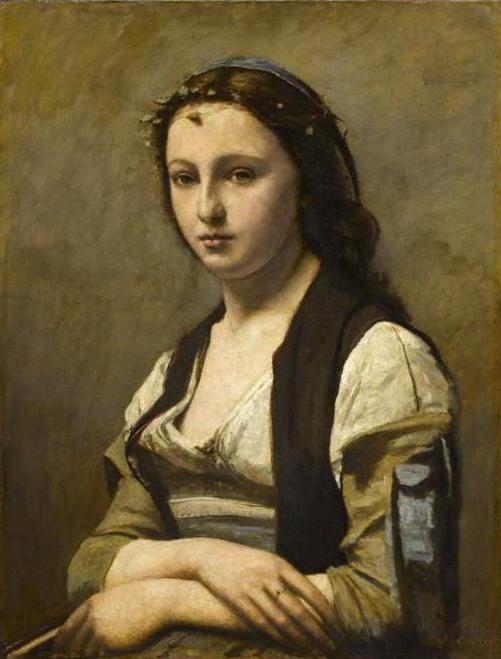Jean-Baptiste Camille Corot (1796–1875) - French artist, very delicate colorist. In his romantic paintings, shades of tone within the same color are used. This allowed him to achieve subtle color transitions, showing a richness of color.
“Portrait of a Woman with a Pearl” (1868–1870), Louvre Museum
This is a chamber work for which Camille Corot took as a model the “Portrait of Mona Lisa” and the work of Jan Vermeer. His model, Berta Goldschmidt, is dressed in one of the Italian dresses that Koro brought from his travels. She does not attract either the brightness of the colors, or the luxury of the clothes themselves. Nothing distracts her eyes from her face. Thus, the artist tries to build contact with the viewer. The lightest veil covers the forehead of a young woman who is seriously looking from the portrait. Her beautiful lips do not even smile, she is so immersed in the contemplation of someone who will stop in front of the picture. This is Leonardo’s welcome. But the great Italian calculated his “Mona Lisa” according to all the laws of mathematics.

Camille Corot did not manage to achieve, or perhaps did not try, repeated repetition of circles, as in the portrait of Leonardo. Only two circles are present here - the head of the young woman and her folded arms. Together this sets a certain rhythm. Like Leonardo, the model has a simple hairstyle - hair freely descends over the shoulders, and from there the veil, and the almost complete absence of jewelry. There is no landscape. A young woman appears as a light ray from an indefinite foggy background, on which (back to Leonardo’s work) the shadows gather in the lower part of the picture. The costume itself and the range of colors lead us to Raphael, and the used pearls make us remember Vermeer. Nevertheless, the portrait is poetic, although not independent.
“Memories of Mortfontaine”
This is a masterpiece that Camille Corot painted in oil on canvas in 1864. A young woman with children is enjoying tranquility by the lake. This is the most poetic work of an experienced master. His picture bears the imprint of an idealized world and at the same time does not lead away from reality. The realistic inclinations of the young Corot combined with romantic elements and laid the bridge between realism and the developing Impressionist movement. In this landscape with the lake, it’s not the details that attract them, but the play of light and a muted palette, much less vivid than the impressionists. Fuzzy, blurry details let us recall the old photographs that the artist collected.

Mortfontaine is a small village in the Oise department in northern France. Earlier, in the 50s, Camille Corot visited these places to study the reflections of light in water. And in “Memoirs” he does not reproduce the landscape in detail, but he recalls this atmosphere full of poetry and serenity, summarizing his impressions. As the artist himself said, “Beauty in art is bathed in the truth that I receive from nature. I always strive to depict a certain place without losing the original freshness of the feeling that possessed me. " The aura of calm, the foggy atmosphere that covers the entire canvas, suggests that we have an early morning. The greenish-brownish tone of the landscape complements the colors of the sky and water, giving the landscape a certain mystery and a special silence in which every rustle is heard and which you can be spellbound to listen to yourself. On the left are a girl with two children, whose figures stand out clearly against the background of a drying tree, on which there are almost no living branches. At this point in the picture, a technique typical for Koro was applied - one bright spot appeared.
"The Bridge in Monte" (1868-1870)
Jean Baptiste Camille Corot travels to his native places and transfers many of them to the canvas. During his life, the artist wrote about three thousand works.
“The bridge in Monte” is one of its most famous landscapes. To paint this landscape, Koro stopped on an island from which the strict geometric lines of the bridge, which contrast with the curved trunks of the foreground trees, were clearly visible.
"Portrait of a Lady in Blue" (1874)
This later work by Corot is on display at the Louvre. On the canvas, standing with his back and half-turned to the viewer, in a laid-back pose is a model with bare hands.
Like blue hyacinth, it stands out against a yellowish background. Nothing distracts the viewer's attention from her. Degas valued Corot's portraits more than landscapes. Under the influence of his portraits were also Van Gogh, Cezanne, Gauguin, and later Picasso.
Jean Baptiste Camille Corot: works
This artist appeared at a time when classical academism was already leaving, and a new direction in art had not yet formed. Therefore, his works are a transitional stage in the history of painting, which does not detract from the work of this painter. He himself is looking for new ways. This is especially evident, because he works mainly in the open air and builds the color scheme within the same color, as was seen from the reproductions presented above. Its subtle halftones (valers) connect the entire surrounding space. It is on them that the unity of the world and man is built. Description of Camille Corot's paintings is given in the test article.